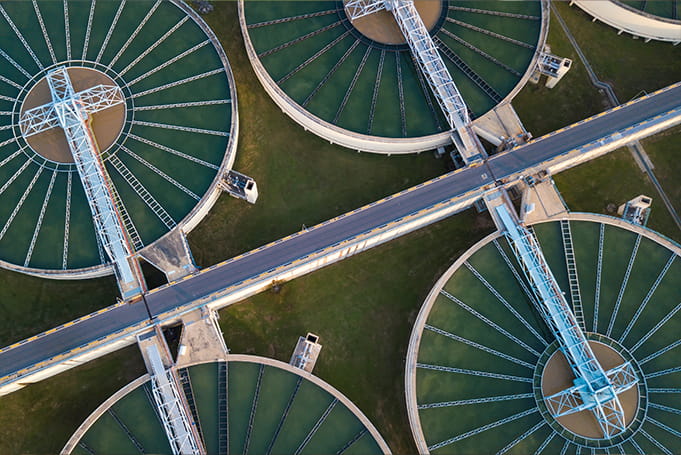5 reasons why climate action needs women

20 SEP 2024
COP29 made headlines earlier this year when the planning committee for the world-leading climate conference was revealed to have 28 members – with not a single woman among them. The backlash was swift, from advocacy groups like She Changes Climate labelling the oversight "a regressive step," and organizations like the UN calling it "shocking,” prompting the addition of 12 women to the board.
The controversy was a stark reminder of a wider problem plaguing efforts to adapt to and mitigate the effects of climate change: the exclusion of women.
As rising temperatures wreak havoc on our environment, women are often left out of climate change discussions and decisions. As we enter a crucial few years in averting climate disaster, here are five reasons it is essential to involve and empower women in the efforts against climate change.
1.Women are more impacted by climate change
The majority of the world’s poor are women, and they often rely heavily on natural resources that are being ravaged by the floods, droughts, landslides, hurricanes and other natural disasters exacerbated by climate change.
Additionally, household responsibilities like childcare, cooking and resource gathering often fall to women. In harsh climates, these already heavy burdens become more difficult, time-consuming and dangerous.

In one example from UN Women, we see how a severe 2022 drought in Ethiopia devastated communities and women particularly. The extreme pressures saw increased rates of girls and women forced into prostitution for survival, domestic violence, forced or early marriage, and girls leaving education to look after family members or assume household responsibilities like food gathering or carrying water.
The effects of climate change on women have been well-documented, ranging from fewer opportunities to rising domestic violence rates to decreased mental health. As those most impacted, women should have a clear and powerful voice in how we confront the challenge of climate change.
2. Women have less access to resources to help them adapt
Across the globe, entrenched gender inequality leaves women doubly impacted. They face harsher blows from crises, with flimsier shields to defend themselves.
With economic and social disparities, women often have less access to vital resources like land, credit, technology, education or economic opportunities. These disparities have immediate impacts for individual women and long-term effects that widen the gender gap – a vicious circle seen in both developed and developing economies.
For example, 80% of people who are displaced by climate change are women. In one vivid example of this inequality, after hurricane Katrina hit New Orleans, of the 1 million people displaced, the majority were African-American single mothers. This changed the shape of the city; there was an 83% decrease in the number of low-income, female-headed households in the city in the months following the storm.
Women have a unique understanding of the blind spots in the mitigation and adaptation efforts that so often fail them. By involving women in consultation, planning and execution, initiatives are more likely to support women effectively, and by extension, support their families and communities.
3. Women have immense potential as agents of change...
Across countries, women wield significant influence in their communities, especially in times of turmoil.
As lynchpins of households and caregivers, women are often directly responsible for the wellbeing of children and community members and are often first responders after a disaster.
In wealthy economies, women and are more likely to participate in sustainable initiatives like recycling, conscious spending, waste reduction and energy conservation programs.

4. ...and women leaders are associated with better sustainable outcomes
Given the opportunity, women have been shown to use this influence for positive climate impact. Research suggests that climate leadership is most effective when women have a seat at the table.
Women have been shown to be more likely than men to be concerned with climate issues. One US survey showed that more than half of women (69%) are concerned that climate change will harm them personally, while for men, this number was 48%. In Europe, surveys show that the share of women who agree that it's important to care for nature and the environment is higher than men, across countries.
This increased preoccupation is reflected in outcomes. Women-led firms have higher environmental, social and governance scores. Companies with three or more female directors perform better on certain measures of environmental performance. Nations with a larger share of women in parliament are more likely to adopt climate-oriented policies.
5. Women are essential to succeeding in the fight against climate change

But the most compelling reason that we should actively involve women in climate action? Climate action will fail without them.
Climate change isn't a fight we can win with half of the global population relegated to the spectator stands. Rising temperatures threaten our food, our water, our health and our future. As the backbone of communities, women wield immense influence and untapped power waiting to be channeled toward the climate crisis.
Women’s knowledge, experience and influence, in households and in boardrooms, is crucial for building a greener, more sustainable world and safeguarding the future for everyone for generations to come.
Related News

04 SEP 2024
Cooling our world is warming our planet. Here’s how we can turn down the heat.

As global temperatures climb, we are ramping up our use of air conditioning. The trouble is, the machines cooling our spaces are significant contributors to global warming. The UAE is rising to the challenge, combining ancient wisdom with avant-garde thinking.
Summer 2024 has brought unprecedented global heat, and new records are being set as the mercury rises. As more of us rely on air conditioning to help keep our homes, offices and public spaces comfortable, our contribution to global warming is rising, too: air conditioning causes around 7% of global greenhouse gas emissions.

Enter sustainable cooling. The UN and the International Energy Agency estimate that climate-friendly cooling could help us avoid up to 460 billion tonnes of greenhouse gas emissions over the next four decades. That’s equivalent to more than ten times India’s current annual GHG emissions.
Cooling our lives without warming our planet
Sustainable cooling encompasses a variety of measures we can take right now to help limit the impact of growing global demand for space cooling. These include improving the efficiency of existing cooling systems, innovation to develop more sustainable cooling technologies and measures that lower ambient temperatures in buildings and urban environments.
Crucially, our response to this challenge must be twofold: as well as upgrading and reimagining the infrastructure which enables today’s cooling systems, we have an opportunity to reduce the need for cooling by designing and building cooler environments in the first place.
Reimagining age-old techniques
The Middle East can draw on a long tradition of ‘passive’ architecture and design techniques which can significantly reduce heat. Rather than fighting the elements by deploying elaborate technologies to counter sweltering temperatures with artificial cold, this approach takes advantage of local conditions. The aim is to work in harmony with the existing environment to reduce the temperature of buildings, without the need for power. In the UAE, techniques include shading devices, double glazing and positioning buildings to channel natural ventilation. Buildings can also be designed with higher thermal mass, so they self-regulate by absorbing daytime heat and releasing it at night. Outside, green roofing, evaporative cooling using water features, and the application of light color coatings have all stood the test of time - and the elements.
In Abu Dhabi, for instance, traditional techniques are being reimagined for today’s needs. The sustainable urban community of Masdar City boasts a modern spin on an ancient wind tower or barjeel, which captures the prevailing wind, channeling it down past cooling mist jets into a central courtyard below. The structure, which designers say can reduce the temperature by 5 degrees celsius at street level, is built with metallic, open sides, to help visitors understand the passive design. Just a few steps away, this time-honored Middle Eastern technique also helps keep Siemens employees cool at the tech company’s innovative regional headquarters.

Elsewhere in Masdar City, the striking Al Bahr Towers combine traditional mashrabiya-style shading with 21st-century technology. The towers are adorned with over 1,000 computerized hexagonal shades which can move and adjust throughout the day, providing shade when the sun is at its strongest.

Efficiency and innovation
The Middle East is also pioneering innovative ways to future-proof buildings, rolling out new approaches to sustainable cooling. Among these, Tabreed operates 89 district cooling plants across the UAE and GCC, using chilled water from centralized energy plants to cool whole neighborhoods via underground pipes. The company is also developing ground-breaking geothermal energy which currently meets 10% of Masdar City's cooling needs. Geothermal cooling, which harnesses energy from beneath the Earth’s surface, reduces energy needs by up to 70% compared with traditional air conditioners.
AI is another tool in the race to make cooling sustainable, with companies like Hyperganic combining algorithmic engineering with industrial 3D printing and engineering to iterate at scale. Partnering with Abu Dhabi-based Strata Manufacturing, Hyperganic has created heat exchangers with radically different structures that could lead to residential air conditioning units that consume 10% of the energy that a conventional device uses.
Progress is being made to reduce leakage rates from traditional air conditioning units, mainly through better design and installation practices. In the UAE, Mubadala Investment Company’s aerospace unit Strata has teamed up with European partners to develop the world’s most energy-efficient residential air-conditioning system in the Emirates.
The hunt is also on to find more climate-friendly solutions than hydroflourocarbons (HFCs), including hydrocarbon refrigerants and ammonia. In keeping with international commitments, the UAE plans to freeze the consumption and production of HFCs in 2028. When coupled with enhanced energy-efficiency measures, these can help reduce both direct emissions from refrigerant leakages and indirect emissions from the energy used to power cooling units.
Sustainable cooling on the climate agenda
As hosts of the COP28 climate conference in 2023, the UAE placed sustainable cooling firmly on the agenda. Chief among outcomes was the Global Cooling Pledge, which saw 60 countries commit to reducing the climate impact of the cooling sector. Spearheaded by the Cool Coalition, a global network dedicated to more climate-friendly cooling, the pledge aims to reduce cooling related emissions by 68% by 2050 and to increase the global average efficiency of new air conditioners by 50% by 2030 at the latest.
Described by the IEA as one of the most critical energy issues of our time, cooling is growing increasingly prominent within the climate change conversation. The shift to more sustainable cooling for our warming world is a formidable challenge. While the planet heats up, we need to ensure we’re not throwing fuel on the fire of global warming while we try to cool down.
By merging ancient wisdom with cutting-edge innovation, we can reduce our reliance on energy-intensive cooling systems and work with the planet to create cooler environments. The Middle East, with its rich history of passive cooling techniques and ambitious climate goals, is uniquely positioned to lead this shift. But only through concerted global efforts to improve cooling efficiency, develop climate-friendly alternatives and prioritize sustainable urban planning can we hope to escape this vicious cycle and ensure a habitable planet for generations to come.

15 AUG 2024
The future of water
Covering most of the planet’s surface, water is seemingly one of the most abundant substances on earth. But today, many communities and countries are facing a usable water crisis.
While millions of people worldwide use hundreds of litres of water a day, around 3.6 billion people – almost half of humanity – survives without access to safe, clean water.
More than an inconvenience, access to clean water is essential for human health, growth, wellbeing and safety, so much so that it has been recognized as a human right. A lack of it can be devastating: 1 million people die each year from lack of access to clean water and sanitation, and every two minutes a child dies from a water-borne disease. Women and girls are particularly affected when clean water is in short supply, often tasked with hauling water over long distances for communities, taking them away from education and exposing them to violent attacks or environmental threats.
Without intervention, the next few decades could make this a reality for more and more people worldwide.
With increasing demand from water-intensive industries like agriculture, rising temperatures and shrinking water reserves, there is a real threat that there won’t be enough water for humanity’s needs. It’s a problem that has had experts ringing alarm bells since before 2017.
With access to water so critical, and the problem so pressing, why isn’t water management demanding more global attention? Is anything being done to bring it into wider conversations about sustainability? On today’s trajectory, what’s the future of water?

The future of water as it stands
Two opposing trends paint a grim picture of the future. While global water use is set to skyrocket, global water supplies are already stressed.
To keep up with demand, experts predict that global water use will rise 20-50% as a result of human-driven climate change and overuse. So much groundwater has been pumped out of the earth that it has tilted the planet’s axis.
Heavy use of water is compounded by mismanagement: without policies, infrastructure and conservation efforts, existing water sources are being polluted, wasted or drained. Worldwide, different challenges in managing water are causing water stress for communities: from outdated infrastructure to conflict to overuse, it’s clear that alongside preserving our existing sources of water, understanding how we use what we have as a global community is just as important.
On this trajectory, developing countries will experience water insecurity over longer periods and with greater intensity, while supplies to major industries become strained. Over the next two decades, the increasing water stress will lead to a rise in related inequality, political instability, growing disease and potential sources of conflict in the most affected nations.
How can we change this trajectory?
Top priorities for cleaner, healthier water
As the global community attempts to address the challenge of building a more sustainable future, the issue of water has garnered more attention. While the subject of water has been historically absent from international sustainability efforts like the Paris Agreement, both COP27 and COP28, held in Dubai in one of the world’s most arid regions, recognized water as a priority.
As governments, institutions and communities examine their relationship with water and their future needs, there is an overall consensus that the battle for water must be fought on all fronts. As a complex issue with multiple causes, it calls for many solutions across government, education, technology and industry, all working in tandem.
Individuals – from ordinary households to decision makers at the helm of major corporations – must gain a better understanding of the impact of water usage and consumption. Awareness campaigns like the USA’s Save Our Water can help change behavior and influence change at the individual level. At the national level, governments can leverage policy to support better understanding and use of water management.
Backed by funding, recent innovations in water management technology have the potential to help restore and manage water. Emerging AI and big data technologies, in particular, hold much promise. A pilot project in the Ramotswa Aquifer between South Africa and Botswana, for example, is harnessing AI to analyze water levels in the drought-prone area, helping identify patterns and inform water management decisions. AI-assisted geospatial analysis is also helping smallholders in Ethiopia to identify shallow well locations, something that promises to significantly improve crop yield and access to drinking water.
While new technologies have the potential to help solve significant challenges, prioritizing cost-effective and culturally compatible solutions remains key. Obstacles like supply chain coordination, training and distribution also need to be overcome for effective implementation. Introducing innovative financial instruments like water credits (akin to carbon credits) could incentivize investment in water-related initiatives and contribute to sustainable water management practices worldwide.

Climate Adaptation and Mitigation
The issue of water is inextricably tied to the wider climate emergency. Meeting the Paris goals by reducing carbon emissions, implementing overall climate mitigation measures and adapting to today’s changes are a key part of addressing the water crisis and building safeguards for the future.
Climate adaptation measures can be integrated into water systems and infrastructure and are essential for building resilience to climate change-induced water scarcity and extreme weather events. This involves implementing strategies such as rainwater harvesting, enhancing water storage capacity, and improving flood management systems to mitigate the impacts of climate change and ensure reliable access to water.
More broadly, general climate mitigation efforts are fundamental for addressing the underlying causes of the global water crisis. By mitigating climate change, we can help stabilize weather patterns, reduce the intensity of droughts and floods, and safeguard water resources for future generations.
Water is a critical resource, and its future is in our hands. To help people access water today and ensure water security for tomorrow, the global community must recognize, invest and mobilize to create better water management practices and safeguard the precious water we have remaining. The task is complex, but vital. We must come together to solve the problems we face for a greener, more sustainable future.

05 AUG 2024
Game on! How sports can advance climate action



